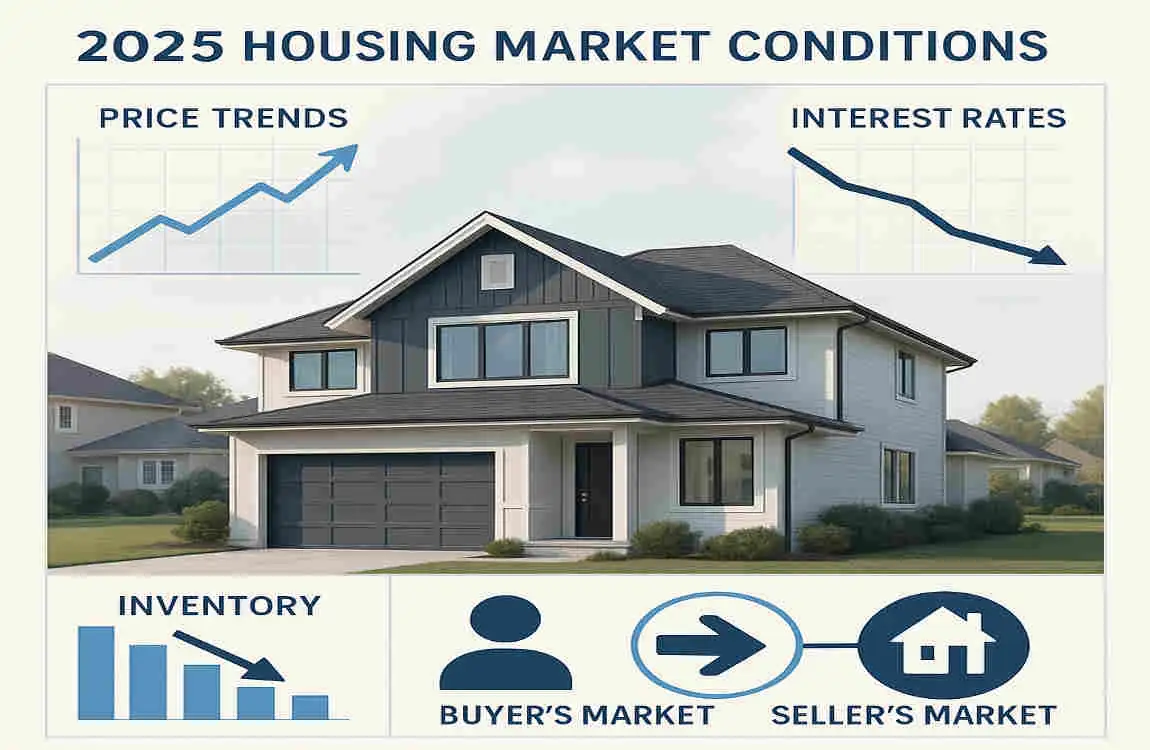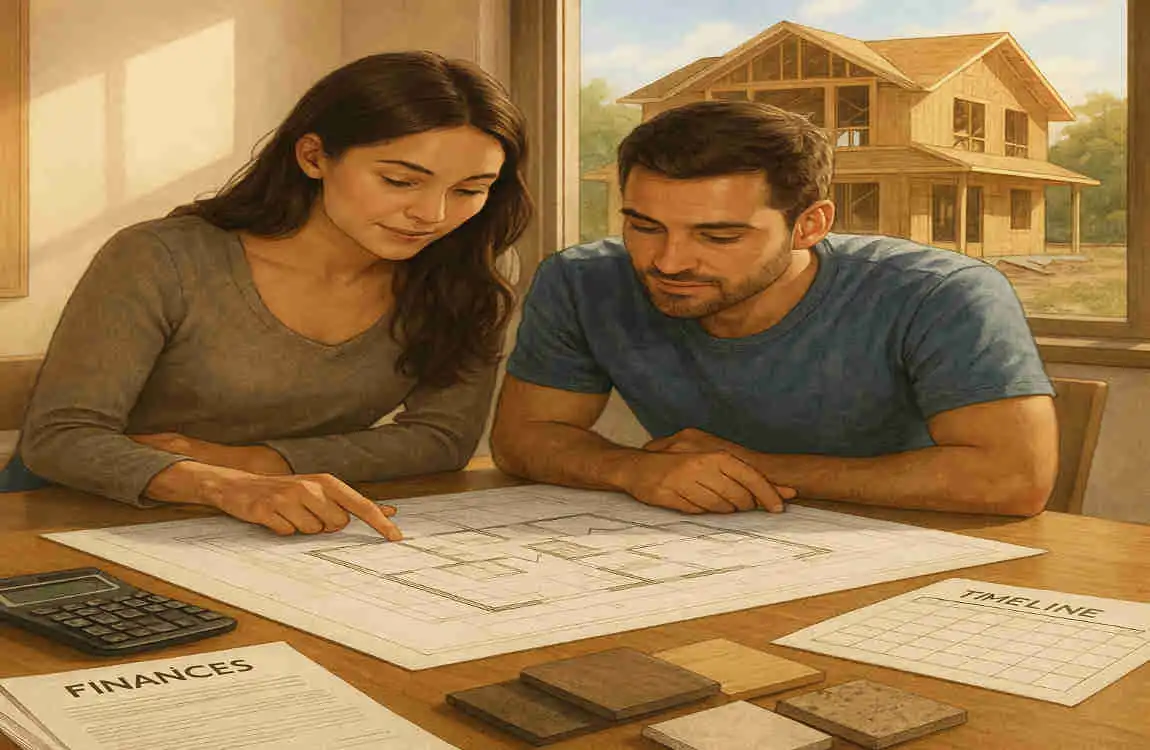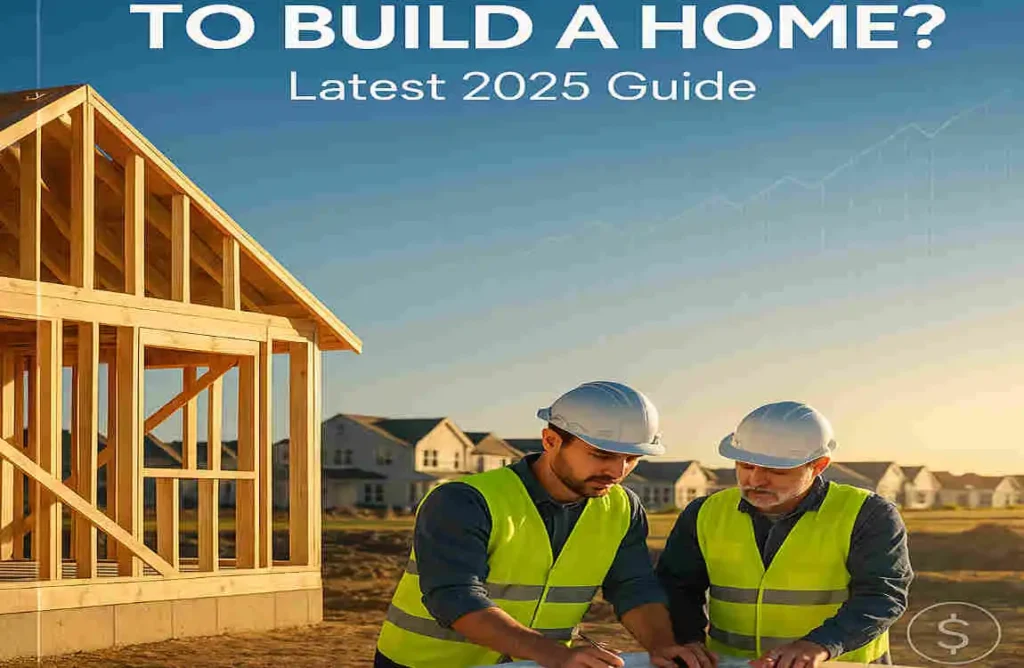Have you been dreaming about building your own home? You’re not alone. The question “Is now a good time to build a home?” echoes through countless conversations at dinner tables and coffee shops across the country. It’s a decision that keeps many potential homeowners awake at night, as they weigh options and crunch numbers.
As we navigate through 2025, the housing market presents a fascinating mix of opportunities and challenges. The landscape has shifted dramatically in just a few years. Interest rates have stabilized after their rollercoaster ride, construction technology has evolved, and buyer preferences have transformed in ways we couldn’t have imagined.
Timing matters more than ever when it comes to building your dream home. The difference between breaking ground today versus waiting six months could mean thousands of dollars saved or spent. It could determine whether you get the materials you want or have to settle for alternatives. Most importantly, it affects how soon you’ll be able to move into that space you’ve been envisioning.
Current 2025 Housing Market Conditions

Market Conditions: Is Now a Good Time to Build a Home in 2025?
The 2025 housing market tells a story of remarkable resilience and adaptation. After years of uncertainty, we’re seeing patterns that offer both encouragement and caution for prospective home builders.
Let’s start with the big picture. The global real estate market has found its footing after the turbulence of recent years. In major urban centers, we’re witnessing a steady demand for new construction, though the pace varies significantly by region. Cities like Austin, Nashville, and Raleigh continue to experience robust growth. Meanwhile, traditional powerhouses like San Francisco and New York show more measured expansion.
Rural and suburban markets present an entirely different narrative. The remote work revolution that began during COVID-19 has permanently altered these landscapes. Small towns within two hours of major cities have become goldmines for builders. These areas offer larger lots at reasonable prices, attracting families seeking space without sacrificing career opportunities.
Economic Factors Shaping Today’s Market
Interest rates sit at a pivotal point in 2025. The Federal Reserve has maintained rates around 5.5%, creating a stable but elevated borrowing environment. This means construction loans cost more than they did in 2021, but they’re predictable. Builders and buyers can plan with confidence, knowing rates won’t swing wildly month to month.
Inflation has cooled considerably from its peak. The annual rate hovers near 3%, helping stabilize material costs. This predictability allows contractors to provide more accurate estimates. You won’t face the shock of prices jumping 20% between quote and construction anymore.
Supply and demand dynamics have shifted dramatically. The inventory of existing homes remains historically low. Many homeowners with sub-3% mortgages are refusing to sell, creating a shortage of available properties. This scarcity drives more people toward new construction as their primary option for homeownership.
The Lasting Impact of Recent Events
The pandemic’s influence on building trends continues to shape decisions in 2025. Home offices remain non-negotiable for most buyers. Outdoor living spaces have evolved from nice-to-have to must-have features. Multi-generational floor plans are gaining popularity as families reconsider their living arrangements.
Health-conscious design elements have become standard. Better ventilation systems, touchless fixtures, and antimicrobial surfaces are now standard in most new construction plans. These features add modest costs but significant value to modern homes.
Current Market Dynamics
Today’s buyer-seller dynamics favor builders in many markets. Existing home sellers maintain high asking prices, banking on limited inventory. This pricing pressure makes new construction increasingly competitive, especially when you factor in customization options and modern efficiency standards.
The relationship between builders and buyers has evolved, too. Builders offer more flexibility in negotiations. They’re willing to cover closing costs, include upgrades, or adjust timelines to secure contracts. This flexibility didn’t exist during the 2021-2022 construction boom.
Land and Inventory Analysis
Land availability varies dramatically by region. Suburban areas show healthy inventory levels with reasonable prices. Urban infill lots remain scarce and expensive. Rural parcels offer the best value but require careful consideration of infrastructure costs.
The current national housing inventory sits at about 3.8 months of supply. This represents improvement from the critical shortages of 2022 but remains below the balanced market level of 6 months. For builders, this means continued strong demand for new construction projects.
Market forecasts from the National Association of Home Builders suggest steady conditions through 2025. They predict a 5% increase in single-family starts compared to 2024. This growth indicates confidence in market fundamentals despite economic headwinds.
Costs Associated with Building a Home in 2025
Understanding the Costs: Building a Home in 2025
Building a home in 2025 requires careful financial planning across multiple cost categories. The total investment extends far beyond just construction materials and labor. Let’s break down each component to give you a realistic picture of what you’re facing.
Land acquisition represents your first significant expense. Lot prices vary wildly based on location, size, and amenities. In suburban markets, expect to pay between $50,000 and $150,000 for a quarter-acre lot. Urban lots command premium prices, often exceeding $200,000 for much smaller parcels. Rural land offers better value per acre, but remember to factor in utility connections and the cost of developing access roads.
Construction and Material Costs
The actual construction costs have stabilized but remain elevated compared to pre-2020 levels. The average price per square foot for new construction ranges from $150 to $250, depending on finishes and regional factors. A 2,500-square-foot home typically costs between $375,000 and $625,000 to build, excluding land.
Material costs tell an interesting story in 2025. Lumber prices have normalized after their wild ride, sitting about 15% above 2019 levels. Concrete and steel remain expensive, driven by ongoing infrastructure projects nationwide. However, innovative materials like engineered wood products and recycled composites offer cost-effective alternatives without sacrificing quality.
The global supply chain has largely recovered, but some specialized items still face delays. European fixtures, exotic stones, and smart home components may require longer lead times. Plan for these delays in your timeline, or consider readily available alternatives that won’t hold up construction.
Labor Market Realities
The skilled labor shortage continues to impact construction costs and timelines. Experienced contractors command premium rates, and for good reason. Quality artistry saves money in the long term by reducing repairs and improving energy efficiency.
Labor costs account for roughly 40% of total construction expenses. In 2025, expect to pay:
- Framing crews: $8-12 per square foot
- Electricians: $75-120 per hour
- Plumbers: $70-110 per hour
- Finish carpenters: $65-95 per hour
Comparing New Construction to Existing Homes
Here’s a detailed comparison table to help you understand the financial differences:
Factor New Construction Existing Home
Initial Cost: Higher upfront investment, Lower purchase price
Customization, Complete control over design, Limited to renovations
Energy Efficiency: Latest standards, lower bills. Varies, often needs upgrades
Maintenance: Minimal for the first 5-10 years, Immediate and ongoing
Warranties: Comprehensive builder warranties, Limited or none
Timeline 6-12 months to complete, 30-60 days to close
Hidden Costs: Landscaping, window treatments, Repairs, updates needed
Hidden Costs Nobody Talks About
Beyond the obvious expenses, several hidden costs can surprise first-time builders. Site preparation might reveal rock formations requiring expensive blasting. Soil tests could mandate additional foundation work. These surprises typically add 5-10% to your budget.
Permit fees vary by municipality but often total $5,000 to $15,000. Impact fees for schools and infrastructure can add another $10,000 to $30,000. Don’t forget to account for temporary housing costs while your home is under construction. These expenses can add $15,000 to $25,000 to your total investment.
Utility connections represent another often-overlooked expense. Running water, sewer, electric, and gas lines to your property can cost $10,000 to $50,000, depending on the distance from existing infrastructure. Septic systems and wells for rural properties add $15,000 to $30,000.
Regional Cost Variations
Building costs vary significantly across the country. The Northeast and West Coast remain the most expensive, with costs often 20-30% higher than the national average. The South and Midwest offer better value, though popular cities like Nashville and Austin have seen costs rise dramatically.
Weather considerations affect both costs and timing. Northern states face shorter building seasons, potentially extending timelines and costs. Southern states face hurricane seasons and extreme heat, requiring specific building standards and materials that add to costs.
Smart budgeting in 2025 means building in a 15-20% contingency fund. This buffer protects against material price fluctuations, change orders, and unexpected site conditions. It’s better to have funds available than to halt construction mid-project.
Brilliant Timing: When Is the Best Time to Build?

Innovative Timing Strategies: Is Now the Right Moment to Build Your Home?
Understanding the cyclical nature of construction can save you thousands of dollars and months of delays. The housing market and construction industry follow predictable patterns that savvy builders use to their advantage.
The construction industry operates on both annual and multi-year cycles. Annual patterns are influenced by weather and demand fluctuations. Multi-year cycles connect to broader economic trends, interest rate movements, and demographic shifts. Recognizing where we stand in these cycles helps you make smarter timing decisions.
Currently, we’re in a stabilization phase of the larger cycle. The frenzied pace of 2021-2022 has cooled. The panic of 2023 has subsided. This balanced middle ground often represents the optimal building window—prices have stabilized, contractors have availability, and materials are generally accessible.
Seasonal Considerations for Construction
Seasonal timing significantly impacts both costs and construction quality. Spring starts remain most popular for good reason. Breaking ground in April or May allows for foundation work during dry months and framing before winter weather arrives.
However, fall starts offer unique advantages in 2025. Contractors have more availability after the summer rush. Material suppliers often offer end-of-year discounts to clear inventory. Starting in September or October means your home could be ready by late spring, perfect timing for the traditional moving season.
Winter planning with spring construction has become increasingly popular. Use November through February to finalize plans, secure permits, and lock in contractor agreements. This approach allows you to hit the ground running when weather permits, avoiding the spring rush for contractors and materials.
Economic Timing Indicators
Several economic indicators suggest 2025 represents a strategic building opportunity. Interest rates have stabilized after years of volatility. While they’re higher than the historic lows of 2020-2021, they’re predictable. This stability allows for accurate long-term planning.
The Federal Reserve signals steady policy through mid-2025. This means construction loan rates should remain consistent, eliminating the risk of dramatic rate increases during your build. Fixed-rate construction-to-permanent loans lock in today’s rates for your entire mortgage term.
Employment markets remain robust in most regions. Unemployment sits near historic lows, providing confidence in income stability. This strong job market supports both your ability to qualify for financing and the long-term value of your investment.
Market Stability and Future Projections
Housing market stability has improved considerably. The wild price swings of recent years have moderated. Home values continue to appreciate but at sustainable 3-5% annual rates rather than the unsustainable 15-20% spikes we witnessed previously.
Building material futures markets suggest stable pricing through 2025. Lumber futures trade in a narrow range. Concrete and steel prices show minimal volatility. This predictability enables accurate budgeting and reduces the risk of cost overruns.
Demographics favor continued housing demand. Millennials are entering prime homebuying years in record numbers. Gen Z begins joining the market in meaningful numbers. This sustained demand supports long-term home values, making current construction a sound investment.
Personal Financial Readiness
Beyond market timing, your personal financial readiness determines the optimal timing for building. Credit scores above 740 unlock the best construction loan rates. Having a 20-25% down payment available provides negotiating leverage and better terms.
Your debt-to-income ratio should sit below 43% including the projected mortgage payment. This ensures comfortable qualification and financial flexibility during construction. Emergency funds covering 6-12 months of expenses protect against unexpected costs or income disruptions.
Consider your career stability and growth trajectory. Are you established in your field with a predictable income? Do you anticipate remaining in the area for at least 5-7 years? These personal factors matter as much as market conditions when timing your build.
The Advantage of Building Now Versus Waiting
Building now offers several advantages:
- Lock in current material prices before potential inflation
- Secure contractor availability before the next boom
- Take advantage of improving but not yet peaked market conditions
- Benefit from current building code standards before potential changes
- Start building equity immediately rather than paying rent
Waiting might make sense if:
- Interest rates show signs of significant decline
- Local market indicators suggest oversupply is developing
- Your personal finances need strengthening
- Major life changes loom on the horizon
Pros and Cons of Building Now
Weighing the Pros and Cons: Is Now a Good Time to Build a Home?
Making the decision to build requires honestly evaluating both opportunities and challenges. Let’s examine the key advantages and potential drawbacks of building in 2025.
Advantages of Building in 2025
Complete customization tops the list of building benefits. You control every detail from floor plan to fixtures. This means creating spaces that perfectly match your lifestyle, whether that’s a massive kitchen for entertaining or a dedicated home gym.
Modern building standards provide significant long-term value. Homes built in 2025 include:
- Superior insulation reduces energy costs by 30-40%
- Advanced HVAC systems with intelligent controls
- Built-in EV charging capabilities
- Solar-ready electrical systems
- Water-efficient plumbing fixtures
The current market conditions favor builders in several ways. Contractor availability has improved from the extreme shortages of 2021-2022. This means better pricing and greater scheduling flexibility. You can actually interview multiple builders and choose based on quality, not just availability.
Technology integration comes standard in new construction. Smart home systems, security features, and energy management tools are built into the infrastructure rather than retrofitted. This seamless integration provides better functionality and reliability.
Potential Challenges and Risks
Higher interest rates compared to recent years affect affordability. Construction loans currently cost 2-3% more than the historic lows many existing homeowners locked in. This translates to hundreds of dollars in additional monthly payments.
Economic uncertainty clouds the outlook. While current indicators remain positive, recession risks persist. Global conflicts, trade disputes, and political transitions could impact market stability. Building during uncertain times requires a financial cushion and emotional resilience.
Material costs remain elevated despite stabilization. While prices aren’t skyrocketing, they’re still 15-25% higher than pre-pandemic levels. This permanent reset in construction costs means building costs are higher than they were five years ago, even after adjusting for inflation.
Timeline uncertainties continue to plague construction projects. Weather delays, inspection backlogs, and material availability can extend projects by months. This means carrying construction loans longer and potentially missing target move-in dates.
Building Now Versus Waiting: A Clear Comparison
Building now means accepting current interest rates but securing today’s material prices. You’ll face known challenges rather than unknown future risks. The stable market provides predictability for planning and budgeting.
Waiting to build gambles on improved conditions that may not materialize. Interest rates might drop, but material costs could spike. Contractor availability might improve, but land prices typically only increase. Each month of waiting also means continued rent payments or living in unsuitable conditions.
The opportunity cost of waiting often exceeds potential savings. If you’re currently renting for $2,000 per month, a year’s delay costs $24,000 in rent with no equity built. That money could cover significant increases in construction costs while still leaving you ahead.
